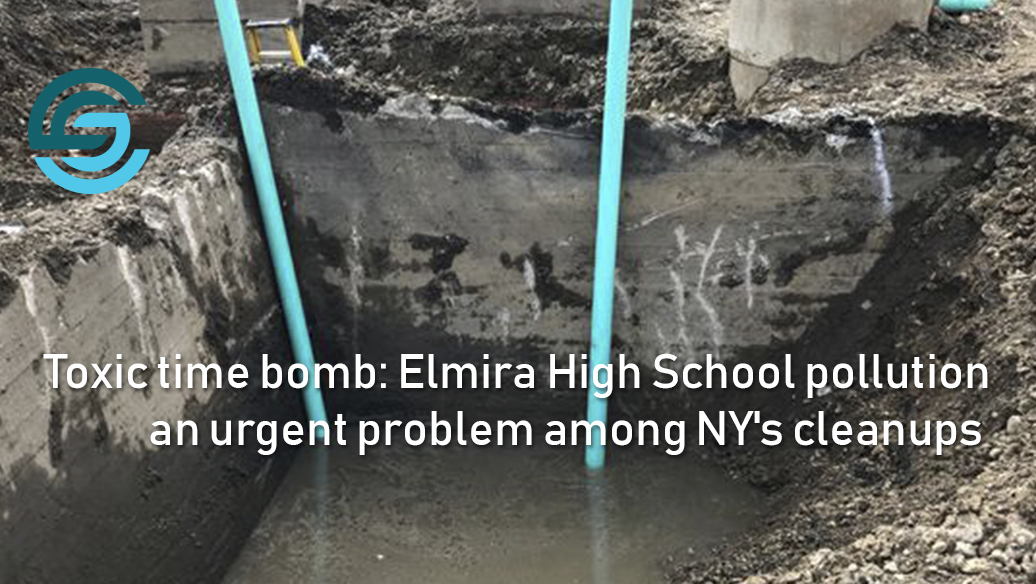[tm_pb_section admin_label=”section”][tm_pb_row admin_label=”Row”][tm_pb_column type=”4_4″][tm_pb_divider admin_label=”Divider” color=”#ffffff” show_divider=”off” height=”50″ height_last_edited=”on|phone” divider_style=”solid”]
[/tm_pb_divider][/tm_pb_column][/tm_pb_row][tm_pb_row admin_label=”Row”][tm_pb_column type=”4_4″][tm_pb_text admin_label=”Text” text_orientation=”justified” use_border_color=”off” border_color=”#ffffff” border_style=”solid”]
While digging up polluted and toxic soil at Elmira High School last summer, excavators hit a jarring surprise three feet below the parking lot — immovable concrete walls extending to unknown depths.
Environmental engineers overseeing the job knew the school was built on land polluted by the former Remington Rand factory, but they didn’t expect to encounter physical remains of the offending structure.
“They were massive,” said Heidi Dudek, a project manager with the state Department of Environmental Conservation. “Industrial relics — that’s the best way to describe them.”
For nearly 50 years, the toxic legacy of the school’s predecessor was out of sight and mostly out of mind. Now, the newly exposed foundation was complicating efforts to remove some 6,800 tons of soil laced with PCBs dumped, spilled or leaked from operations they once supported.
The find was unexpected, but not unique.
Across New York state, nearly 1,300 active toxic legacy sites and hundreds of suspected sites sit beneath the surface like the one at Elmira High School, according to an Elmira Star-Gazette analysis of state DEC records.
The pollution comes from former operations of the biggest names in 20th-century American manufacturing — IBM, Kodak, General Electric, Westinghouse, Xerox — as well as neighborhood machine shops and dry cleaners.
A legacy of pollution might seem a simple footnote in New York’s environmental history, but like the forgotten hazards at Elmira High School, the dangers linger. While our memories might be short or our attention may have wandered, long-buried pollutants still exist.
PCBs and industrial solvents such as TCE are among the most insidious and pervasive of these hazards. They can cause illnesses ranging from cancer to nerve damage. Colorless and odorless, they are essentially invisible to people working at or near polluted sites, where they can remain in the ground for generations, and flow with air and water to new areas.
The old factory foundation under the parking lot is one of many revelations recently uncovered at the Elmira school as Unisys, Remington Rand’s successor, makes incremental progress cleaning a monumental problem.
Last March, an investigation in the Star-Gazette reported that after almost 50 years, the extent of the pollution still is unknown, the cleanup is far from complete, and more problems lurk below the surface.
That Star-Gazette investigation sparked a renaissance of community involvement that, many believe, is the last, best hope for fixing the problem.
“It raised awareness to get people re-engaged and re-oriented with the issue,” said Andy Patros, a lifelong resident and former Chemung County legislator. “It was a wake-up call.”
More than 200 residents and parents attended a public meeting in April to urge environmental and health officials to make the school cleanup a high priority.
Soon after, with anger and disillusion running high, the Chemung County Legislature, Elmira City Council, Town of Southport and Town of Elmira passed resolutions urging the state to accelerate the cleanup.
“We heard from the community and the school loud and clear,” DEC Chief of Staff Sean Mahar said in a recent interview. “They want this cleaned up. We are stepping up.”
Last summer, technicians collected 1,360 samples on the football field and found PCB levels increasing in concentration from an inch or two below the surface up to 14 feet deep. Some hot spots exceeded cleanup standards by a factor of 1,000 or more.
School activities were discontinued on the high school field, which had been used for modified and junior varsity sports, and physical education classes for almost 40 years. The cleanup under the field, in limbo for years while administrators tried to time the work to capital improvements, is now scheduled for next summer.
Source: Star Gazette
[/tm_pb_text][/tm_pb_column][/tm_pb_row][tm_pb_row admin_label=”row”][tm_pb_column type=”4_4″][tm_pb_divider admin_label=”Divider” color=”#ffffff” show_divider=”off” height=”20″ height_last_edited=”on|phone” divider_style=”solid”]
[/tm_pb_divider][/tm_pb_column][/tm_pb_row][/tm_pb_section]

